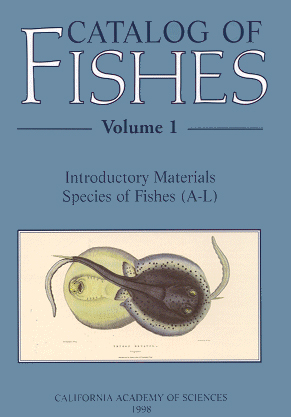Science News
The Importance of Names
January 22, 2013

by Barbara Tannenbaum
Last year, more than a million distinct visitors clicked onto the Academy’s website. In the web page popularity contest, which part of the site comes out on top? The numbers show that the Catalog of Fishes, an encyclopedic database of the world’s known fish species, remains the single most referenced resource of the Academy’s many digital offerings.
“The beginning of wisdom is to call things by their proper name,” wrote Confucius more than two thousand years ago. This need to consult an authoritative reference guide has compelled scientists numbering in the thousands from around the world—including Japan, Brazil, Germany, Australia, Mexico, the Philippines, and elsewhere—to consult the database painstakingly assembled over twenty-five years by William N. Eschmeyer, a curator emeritus in the Ichthyology section of the Academy's Department of Vertebrate Zoology and Anthropology.
Eschmeyer, a Tennessee native who came to the Academy in 1967, began his career as a traditional taxonomist focusing on scorpionfish and stonefish. Dave Catania, senior collections manager in Ichthyology, remembers when Eschmeyer got the itch in the late 1980s to create a taxonomic compendium for the world’s fish species. “He applied for a National Science Foundation grant and got turned down,” he says. “They said it was too big a project.”
In 1988, Eschmeyer revised his proposal to compile and publish a manageable list of 10,000 genera of fish. “He knocked that out in three years,” says Catania. “That enabled him to get funding for his original goal of cataloging fish species.”
Now retired and based in Gainesville, FL, Eschmeyer still monitors and updates revisions to the catalogue from his office at the University of Florida. He receives assistance from numerous volunteers and colleagues such as Ron Fricke in Germany, Dennis Polack in South Africa, and Nicolas Bailly of Fishbase.org.
The reference work contains more than a list of Latin names of genus and species. A typical record will include the genus, species, author, year, catalog number of the primary type and the museum where it’s held, type locality and geographic distribution, and citations of the original published descriptions and subsequent status references.
Catania explains that Eschmeyer began his work by scouring the scientific literature in libraries around the world. “He hired colleagues to translate reference materials in Russian and German,” he says. “The catalog has citations dating back to the 1800s. Some entries go back even further to Linnaeus.”
In 1998, when a print version of the catalog was last published, it ran 2905 pages and comprised three volumes. Subsequent versions came with updated information on CD-ROM. Now, the definitive version of the catalog exists as an online database.
It is updated every two months by Jon Fong, a programmer at the Academy and Ichthyology curatorial assistant.
In January, with a press of the button at his computer, Fong updated the list of the world’s names for described species of fishes to 60,229. In 2012, Fong says, researchers described 457 new fish species. In the past twenty years, ichthyologists have added an average of 340 new species each year.
“Wait ten minutes,” laughs Dave Catania, “and there might be more.”
There could also be less. Of the 60,229 species comprising the catalog, only slightly more than half—32,590—are considered valid. From a scientific standpoint, that’s perfectly fine.
“I do remember one talk Bill gave at the annual meeting of the American Society of Ichthyologists and Herpetologists,” says Catania. “He posted a list with two columns —one indicated the number of species described by each author. The other listed what he called ‘batting averages.’ In other words, the percentage of all species described by an author still considered to be valid. There were so many attendees milling about the room, looking at the list, you’d think that he’d posted their test scores. In a sense, he did.”
That said, classifications of species are dynamic and change over time. “The naming conventions we apply to biological families, genera and species represent our conclusions about how these entities are related,” explains Stan Blum, the Academy’s research information manager. “We reevaluate the limits and relationships among species, and the groups we name represent that information.”
As researchers armed with increasingly powerful tools delve into genetic materials and add to other data sets, scientists need to reevaluate the significance of certain features and variations once considered definitive.
“There is a logic to these rules,” says Blum. “Classification gives you a framework to look at the history of life—to trace back, make comparisons, sketch out the phylogenetic tree.”
By compiling an exhaustive catalog of source material and new discoveries, “Eschmeyer,” says Blum, “has helped stabilize ichthyology’s nomenclature and created an invaluable, authoritative reference for his field.”
And his work propels him to the top ranks of the Academy’s web popularity to boot!
Barbara Tannenbaum is a science writer working with the Academy's Digital Engagement Studio. Her work has appeared in the New York Times, San Francisco Magazine and many other publications.